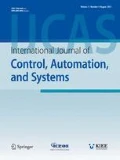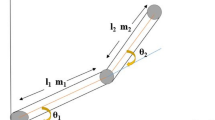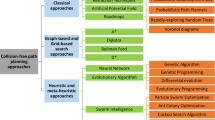Abstract
In this study, a novel control strategy that combines a fuzzy system and the sliding mode controller is proposed for improving stability and achieving high-accuracy control in service robots. Based on the kinematic and dynamic models of a 4-degrees of freedom manipulator, and the observed tracking error using a low-cost inertial sensor, the proposed fuzzy sliding mode controller (FSMC(IMU)) is designed to generate appropriate torques at robot joints. The FSMC(IMU) controller parameters are adjusted through a fuzzy rule that determines the state of the system. The error in trajectory tracking is reduced through this. The gain value K can be finely adjusted by fuzzy control by observing the degree of vibration after entering the sliding mode surface. The larger the observed vibration value, the faster the fuzzy controller follows the given input trajectory by selecting a smaller gain value K and reducing jitter due to the sliding mode control’s discontinuous switch characteristics. When the degree of error is small, it achieves faster and more accurate control performance than when the observer is not used. The stability of the FSMC(IMU) system is verified via disturbance experiments. The experimental data are compared with the conventional sliding mode controller and proportional-derivative control. The experimental results demonstrate that the proposed FSMC(IMU) controller is stable, fast, and highly accurate in controlling service robots.
Similar content being viewed by others
References
T. Haidegger, “Autonomy for surgical robots: Concepts and paradigms,” IEEE Trans. on Medical Robotics and Bionics, vol. 1, no. 2, pp. 65–76, May 2019.
H. Wang, T. Lu, B. Niu, H. Yan, X. Wang, J. Chen, and Y. Li, “Research on fuzzy PID control algorithm for lower limb rehabilitation robot,” Proc. of IEEE 4th Information Technology and Mechatronics Engineering Conference (ITOEC 2018), Chongqing, China, 2018.
T. Shu, S. Gharaaty, W. Xie, A. Joubair, and I. A. Bonev, “Dynamic path tracking of industrial robots with high accuracy using photogrammetry sensor,” IEEE/ASME Trans. on Mechatronics, vol. 23, no. 3, June 2018.
R. Garrido and M. A. Trujano, “Stability analysis of a visual PID controller applied to a planar parallel robot,” International Journal of Control, Automation and Systems, vol. 17, no. 6, pp. 1589–1598, 2019.
J. Baek, W. Kwon, and C. Kang, “A new widely and stably adaptive sliding-mode control with nonsingular terminal sliding variable for robot manipulators,” IEEE Access, vol. 8, pp. 43443–43454, 2020.
M. Namazov, “Fuzzy logic control design for 2-link robot manipulator in MATLAB/Simulink via robotics toolbox,” Proc. of Global Smart Industry Conference (GloSIC), Chelyabinsk, Russia, Nov. 2018.
S. Li, J. He, Y. Li, and M. U. Rafique, “Distributed recurrent neural networks for cooperative control of manipulators: A game-theoretic perspective,” IEEE Trans. on Neural Networks and Learning Systems, vol. 28, no. 2, pp. 415–426, Feb. 2017.
R.-J. Wai and Z.-W. Yang, “Adaptive fuzzy neural network control design via a T-S fuzzy model for a robot manipulator including actuator dynamics,” IEEE Trans. on Systems, Man, and Cybernetics-Part B: Cybernetics, vol. 38, no. 5, pp. 1326–1346, October 2008.
R. Wang, H. Jing, J. Wang, M. Chadli, and N. Chen, “Robust output-feedback based vehicle lateral motion control considering network-induced delay and tire force saturation,” Neurocomputing, vol. 214, pp. 409–419, 2016.
J. Yu, J. Liu, Z. Wu, and H. Fang, “Depth control of a bioinspired robotic dolphin based on sliding-mode fuzzy control method,” IEEE Trans. on Industrial Electronics, vol. 65, no. 3, pp. 2429–2438, March 2018.
B. Xing, L. Guo, S. Wei, and Y. Song, “Dynamic modeling and sliding mode controller design of a variable structure two-wheeled robot,” Proc. of the IEEE International Conference on Information and Automation, Ningbo, China, August 2016.
G. M. Dimirovski, Y. Liu, J. Wang, and Y. Kao, “Overcoming control complexity of constrained three-link manipulator using sliding-mode control,” IEEE International Conference on Systems, Man, and Cybernetics, Budapest, Hungary, October 9–12, 2016.
J. Wang, X. Wang, and J. Wang, “Trajectory tracking controller design for a quadrotor aircraft based on fuzzy sliding-mode control,” Proc. of the 36th Chinese Control Conference, Dalian, China, July 26–28, 2017.
J. Baek, M. Jin, and S. Han, “A new adaptive sliding-mode control scheme for application to robot manipulators,” IEEE Trans. on Industrial Electronics, vol. 63, no. 6, pp. 3628–3637, June 2016.
H. Hu and P.-Y. Woo, “Fuzzy supervisory sliding-mode and neural-network control for robotic manipulators,” IEEE Trans. on Industrial Electronics, vol. 53, no. 3, pp. 930–940, June 2006.
J. Qui, W. Ji, and M. Chadli, “A novel fuzzy output feedback dynamic sliding mode controller design for two-dimensional nonlinear systems,” IEEE Transactions on Fuzzy Systems, 2020. DOI: https://doi.org/10.1109/TFUZZ.2020.3008271
G. Wang, M. Chadli, and M. Basin, “Practical terminal sliding mode control of nonlinear uncertain active suspension systems with adaptive disturbance observer,” IEEE/ASME Transactions on Mechatronics, vol. 26, no. 2, pp. 789–797, 2021.
Y. Wang, X. Xie, M. Chadli, S. Xie, and Y. Peng, “Sliding mode control of fuzzy singularly perturbed descriptor systems,” IEEE Transactions on Fuzzy Systems, 2020. DOI: https://doi.org/10.1109/TFUZZ.2020.2998519
M. M. Fateh and S. Khorashadizadeh, “Robust control of electrically driven robots by adaptive fuzzy estimation of uncertainty,” Nonlinear Dynamics, vol. 69, pp. 1465–1477, 2012.
M. M. Fateh, S. Azargoshasb, and S. Khorashadizadeh, “Model-free discrete control for robot manipulators using a fuzzy estimator,” The International Journal for Computation and Mathematics in Electrical and Electronic Engineering, vol. 33, pp. 1051–1067, April 2014.
S. M. H. Zadeh, S. Khorashadizadeh, M. M. Fateh, and M. Hadadzarif, “Optimal sliding mode control of a robot manipulator under uncertainty using PSO,” Nonlinear Dynamics, vol. 84, pp. 2227–2239, 2016.
C. Liu, F. Chen, X. Sui, H. Cheng, J. Xu, and Y. Xue, “Gesture detection and data fusion based on MPU9250 sensor,” IEEE 12th International Conference on Electronic Measurement & Instruments, Qingdao, China, 2015.
M. Boukens, A. Boukabou, and M. Chadli, “A real time self-tuning motion controller for mobile robot systems,” IEEE/CAA Journal of Automatica Sinica, vol. 6, no. 1, pp. 84–96, 2019.
M. Boukens, A. Boukabou, and M. Chadli, “Robust adaptive neural network-based trajectory tracking control approach for nonholonomic electrically driven mobile robots,” Robotics and Autonomous Systems, vol. 92, pp. 30–40, 2017.
G. S. Nhivekar, S. S. Nirmale, and R. R. Mudholker, “Implementation of fuzzy logic control algorithm in embedded microcomputers for dedicated application,” International Journal of Engineering, Science and Technology, vol. 3, no. 4, pp. 276–283, 2011.
X. Kang, W. Shen, W. Chen, and J. Wang, “The control of dynamixel RX-28 based on VC++ for the locomotion of cockroach robot,” Proc. of 4th IEEE Trans. on Industrial Electronics and Applications, Xi’an, China, May 2009.
A. Zainuddin, B. Ali, M. Zan, R. Hashim, and H. Hashim, “An open-architecture humanoid robot controller in support of developmental disability(DD) rehabilitation,” Proc. of International Conference on Electrical, Electronics and System Engineering(ICEESE), Kanazawa, Japan, November 2017.
E. Slotine and W. Li, “Adaptive manipulator control: A case study,” IEEE Trans. on Automatic Control, vol. 33, no. 11, pp. 995–1003, November 1988.
A. A. Mohammed and A. Eltayeb, “Dynamics and control of a two-link manipulator using PID and sliding mode control,” Proc. of International Conference on Computer, Control, Electrical, and Electronics Engineering (ICCCEEE), Khartoum, Sudan, Nov. 2018.
V. T. Yen, W. Y. Nan, and P. V. Cuong, “Robust adaptive sliding mode neural networks control for industrial robot manipulators,” International Journal of Control, Automation and Systems, vol. 17, no. 3, pp. 783–792, 2019.
M. Rahmani and M. H. Rahman, “Adaptive neural network fast fractional sliding mode control of a 7-DoF exoskeleton robot,” International Journal of Control, Automation and Systems, vol. 18, no. 1, pp. 124–133, 2020.
C. Sun, G. Gong, and H. Yang, “Sliding mode control with adaptive fuzzy immune feedback reaching law,” International Journal of Control, Automation and Systems, vol. 18, no. 2, pp. 363–373, 2020.
Author information
Authors and Affiliations
Corresponding author
Additional information
Publisher’s Note Springer Nature remains neutral with regard to jurisdictional claims in published maps and institutional affiliations.
This research was supported by the National Research Foundation of Korea(NRF) grant funded by the Korea government(MSIT) (No. 2019R1A2C2088859).
Le Bao received his B.S. degree in electronics engineering from Daegu University, Korea, in 2018. Now he is pursuing a master’s degree in Pusan National University, Korea. His research interests include robot control, sliding mode control, computer vision, sensor application and virtual reality simulation.
Dongeon Kim received his B.S. degree in electronic engineering from Inje University, Korea, in 2015 and an M.S. degree from Pusan National University, Korea, in 2017. Now he is pursuing a doctoral degree in Pusan National University, Korea, and his research interest includes robot system design, intelligent control, and machine learning.
Seung-Joon Yi received his B.S., M.S., and Ph.D. degrees in electronics engineering from Seoul National University, Seoul, Korea, and has worked as a visiting scholar and a postdoctoral scholar at the University of Pennsylvania. He is currently an assistant professor in the Department of Electrical Engineering at the Pusan National University. His main research interest is leveraging machine learning approaches to build more robust and intelligent robotic systems.
Jangmyung Lee received his B.S. and M.S. degrees in electronics engineering from Seoul National University, Seoul, Korea, in 1980 and 1982, respectively, and his Ph.D. degree in computer engineering from the University of Southern California (USC), Los Angeles, in 1990. Since 1992, he has been a professor with the Intelligent Robot Laboratory, Pusan National University, Busan, Korea. His current research interests include intelligent robotic systems, ubiquitous ports, and intelligent sensor. Prof. Lee is a past president of the Korean Robotics Society, and a Vice president of ICROS. He is also the head of National Robotics Research Center, SPENALO.
Rights and permissions
About this article
Cite this article
Bao, L., Kim, D., Yi, SJ. et al. Design of a Sliding Mode Controller with Fuzzy Rules for a 4-DoF Service Robot. Int. J. Control Autom. Syst. 19, 2869–2881 (2021). https://doi.org/10.1007/s12555-020-0452-3
Received:
Revised:
Accepted:
Published:
Issue Date:
DOI: https://doi.org/10.1007/s12555-020-0452-3




